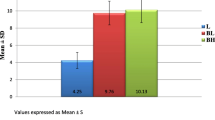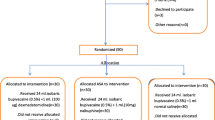Abstract
Lumbar plexus block has been shown to be effective for providing postoperative analgesia after major hip surgeries in children. The goal of the study was to evaluate the feasibility of ultrasound guidance during lumbar plexus block in children undergoing hip surgery for congenital hip dislocation. After obtaining local institutional ethical committee approval and parental informed consent, ASA I or II, 1–6 years old children undergoing hip surgery were included into the study. Lumbar plexus block was performed after general anaesthesia using ultrasound guided Shamrock Method. Bupivacaine 0.25 % was used during block performance. Dose of the local anaesthetic was 1 ml/kg and the maximum dose was limited to 20 ml. In the postoperative period pain was assessed using modified CHEOPS (Children’s Hospital Eastern Ontario Pain Scale) pain score. If pain score in the postoperative period exceeded 3, patients received IV paracetamol 15 mg/kg−1. Morphine 0.1 mg/kg−1 IV was planned to administer if pain scores were still higher than 3 despite paracetamol treatment. 75 patients whose mean age was 47 months were enrolled into the study. All blocks were performed successfully and without complications. Mean time for the first analgesic is found as 10 h after surgery. Only one patient required morphine in the recovery unit and 23 patients received paracetamol. US guided lumbar plexus block using Shamrock Method is an effective technique for providing postoperative analgesia after hip surgeries in children and it’s effect lasts for 8–12 h after surgery.


Similar content being viewed by others
References
Menzies R, Congreve K, Herodes V, Berg S, Mason DG. A survey of pediatric caudal extradural anesthesia. Paediatr Anaesth. 2009;19:829–36.
Omar AM, Mansour M, Kamal AS. Psoas compartment block for acute postoperative pain management after hip surgery in paediatrics. Reg Anesth Pain Med. 2011;36:121–4.
Capdevila X, Coimbra C, Choquet O. Approaches to the lumbar plexus: success, risks, and outcome. Reg Anesth Pain Med. 2005;30:150–62.
Karmakar MK, Li JW, Kwok WH, Soh E, Hadzic A. Sonoanatomy relevant for lumbar plexus block in volunteers correlated with crosssectional anatomic and magnetic resonance images. Reg Anesth Pain Med. 2013;38:391–7.
Salviz EA, Gurkan Y, Tekin M, Buluc L. Ultrasound-guided psoas compartment block and general anesthesia for arthroscopic knee surgery: a case report. Agriculture. 2014;26:34–8.
Sauter AR, Ullensvang K, Bendtsen TF, Borglum J. The “Shamrock Method” a new and promising technique for ultrasound guided lumbar plexus block. Br J Anaesth. 2013. (http://bja.oxfordjournals.org/forum/topic/brjana_el%3B9814).
Aksu C, Gurkan Y. Shamrock method may prevent kidney injury. Br J Anaesth. 2013. (http://bja.oxfordjournals.org/forum/topic/brjana_el%3B9814).
Lin JA, Lu HT, Chen TL. Ultrasound standard for lumbar plexus block. Br J Anaesth. 2014;113:188–9.
Gurkan Y, Aksu C, Toker K, Solak M. Ultrasound guided psoas block using shamrock method for developmental dysplasia of the hip: case report. Br J Anaesth. 2013. (http://bja.oxfordjournals.org/forum/topic/brjana_el%3B11671).
Splinter WM, Semelhago LC, Chou S. The reliability and validity of a modified CHEOPS pain score. Anesth Analg. 1994;78:S413.
Dadure C, Bringuier S, Mathieu O, et al. Continuous epidural block versus continuous psoas compartment block for postoperative analgesia after major hip or femoral surgery in children: a prospective comparative randomized study. Ann Fr Anesth Reanim. 2010;29:610–5.
Touray ST, de Leeuw MA, Zuurmond WW, Perez RS. Psoas compartment block for lower extremity surgery: a meta-analysis. Br J Anaesth. 2008;101:750–60.
de Leeuw MA, Zuurmond WW, Perez RS. The psoas compartment block for hip surgery: the past, present, and future. Anesthesiol Res Pract. 2011;. doi:10.1155/2011/159541.
Auroy Y, Benhamou D, Bargues L, et al. Major complications of regional anesthesia in France: the SOS regional anaesthesia hotline service. Anesthesiology. 2002;97:1274–80.
Breslin DS, Martin G, Macleod DB, D’ercole F, Grant SA. Central nervous system toxicity following the administration of levobupivacaine for lumbar plexus block: a report of two cases. Reg Anesth Pain Med. 2003;28:144–7.
Weller RS, Gerancher JC, Crews JC, Wade KL. Extensive retroperitoneal hematoma without neurologic deficit in two patients who underwent lumbar plexus block and were later anticoagulated. Anesthesiology. 2003;98:581–5.
Capdevila X, Macaire P, Dadure C, et al. Continuous psoas compartment block for postoperative analgesia after total hip arthroplasty: new landmarks, technical guidelines, and clinical evaluation. Anesth Analg. 2002;94:1606–13.
Dadure C, Raux O, Guadard P, et al. Continuous psoas compartment blocks after major orthopedic surgery in children: a prospective computed tomographic scan and clinical studies. Anesth Analg. 2004;98:623–8.
Ilfeld BM, Ball ST, Gearen PF, et al. Ambulatory continuous posterior lumbar plexus nerve blocks after hip arthroplasty. Anesthesiology. 2008;109:491–501.
Bendtsen TF, Pedersen EM, et al. The suprasacral parallel shift vs lumbar plexus blockade with ultrasound guidance in healthy volunteers: a randomised controlled trial. Anaesthesia. 2014;69:1227–40.
Stevens RD, Van Gessel E, Flory N, Fournier R, Gamulin Z. Lumbar plexus block reduces pain and blood loss associated with total hip arthroplasty. Anesthesiology. 2000;93:115–21.
Biboulet P, Morau D, Aubas P, Bringuier-Branchereau S, Capdevila X. Postoperative analgesia after total-hip arthroplasty: comparison of intravenous patient-controlled analgesia with morphine and single injection of femoral nerve or psoas compartment block: a prospective, randomized, double-blind study. Reg Anesth Pain Med. 2004;29:102–9.
Becchi C, Al Malyan M, Coppini R, Campolo M, Magherini M, Boncinelli S. Opioid-free analgesia by continuous psoas compartment block after total hip arthroplasty: a randomized study. Eur J Anaesthesiol. 2008;25:418–23.
Sauter AR, Ullensvang K, Niemi G, Lorentzen HT, Bendtsen TF, Børglum J, Pripp AH, Romundstad L. The Shamrock lumbar plexus block The minimum effective local anaesthetic volume for a new ultrasound-guided lumbar plexus technique. Eur J Anaesthesiol. 2015;32:1–7.
Authors contribution
YG: Study design and data analysis; writing up the first manuscript. CA: Study design and data analysis; writing up the first manuscript. AK: Study design, patient recruitment, data collection. KT: Study design, Critical reading. MS: Study design, Critical reading.
Author information
Authors and Affiliations
Corresponding author
Ethics declarations
Conflict of interest
The authors declare that there are no conflicts of interest.
Rights and permissions
About this article
Cite this article
Gürkan, Y., Aksu, C., Kuş, A. et al. One operator’s experience of ultrasound guided lumbar plexus block for paediatric hip surgery. J Clin Monit Comput 31, 331–336 (2017). https://doi.org/10.1007/s10877-016-9869-x
Received:
Accepted:
Published:
Issue Date:
DOI: https://doi.org/10.1007/s10877-016-9869-x




